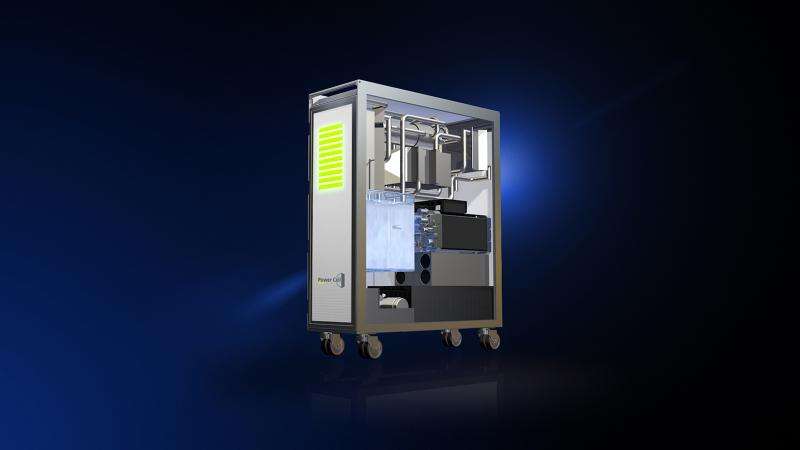Added power for airplane galleys

The galleys inside airliners voraciously consume power - a vital yet limited resource in a plane. Additional power units may soon come to the rescue: housed inside trolley carts in the galleys, these units deliver both supplemental power and thus uncouple the power to the cabin and the kitchen from that which is supplied to the rest of the aircraft. This novel technology is a debut feature on Trade Days at the International Paris Air Show, June 15 to 21.
Airplanes are built for long life: their use typically spans several decades. Interior furnishings in the cabins get renovated many times over the lifetime of the aircraft, same as the galleys. This pattern, however, harbors a certain problem: obsolete equipment is replaced by new equipment that usually requires more power - be they high-performance galley appliances, or amenities like miniature TVs in each individual seat back rest. Yet an airplane's available power - generated in-flight by the turbines - is a limited resource. An auxiliary power unit supplies requisite power during periods when the turbines are not running, such as when passengers board or disembark.
There's another hitch: once you add subsequent electrical loads in the passenger section of the cabin, then the power system of the entire airplane has to be re-approved and reauthorized, because new devices could disrupt the power supply and in a worst case scenario, paralyze the whole system.
Additional power supply to the galleys
A supplemental power unit in each galley in the shape of a movable trolley cart provides power. Researchers at the ICT-IMM branch of the Fraunhofer Institute for Chemical Technology ICT engineered the system in joint collaboration with Diehl Aerospace GmbH and the German Aerospace Center DLR. "This new power source lets us eliminate the energy shortfall," states Prof. Dr. Gunther Kolb, Department Head at ICT-IMM. The cart can even facilitate the approval process since it does not need new approval every time the airplane gets a retrofit or a face-lift: The power supplied to the galleys and cabins is autonomous of the power to the rest of the aircraft.
Reformer and fuel cell
For their clever innovation, the researchers relied on fuel cells: they not only generate power efficiently, but quietly as well. However, things are not that cut-and-dried when it comes to using fuel in mid-air. Because hydrogen can only be stored in containers pressurized to roughly 800 bar: a considerable risk in the airplane's cargo hold. This also precludes combustible fluids, like gasoline. "We use propylene glycol," Kolb reveals. There is a major advantage: it is a liquid substance, i.e., it requires no pressurized containers, becomes non-flammable when mixed with water and, in addition, it is non-toxic. Moreover, it is already being used in airplanes as a coolant and de-icing agent.
Propylene glycol consists of hydrogen, carbon and oxygen. A chemical system, the reformer, breaks down the liquid and extracts the hydrogen, which flows directly into the fuel cell and thus, enerngizes it. Since the carbon monoxide resulting from hydrogen production is not healthy for either the passengers and flight crew or for the fuel cell, the reformer transforms it into a non-toxic carbon dioxide. The system has its origins at Fraunhofer's laboratories. The employees not only engineered the requisite catalysts that were available in it, they also made sure that the device would take up the least amount of a plane's precious space. "In the current reformer, we successfully configured the components that break down the carbon monoxide in a way that saves 90 percent more space than with conventional technology," Kolb affirms.
The research team has already produced a mock-up of the reformer - even the individual components are in place available. Over the next few months, these scientists will assemble and test the very first prototype. They will unveil their innovative technology on Trade Days at the International Paris Air Show, June 15 to 21 (Hall 1, Booth G316).
Provided by Fraunhofer-Gesellschaft





















